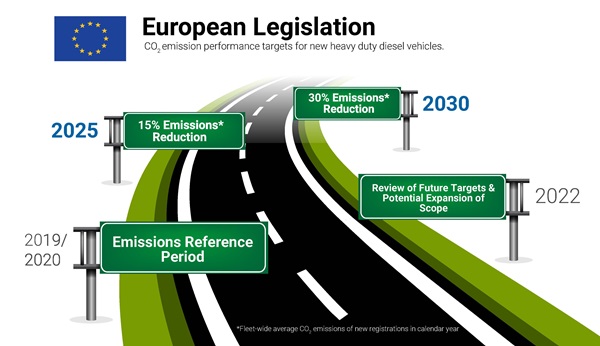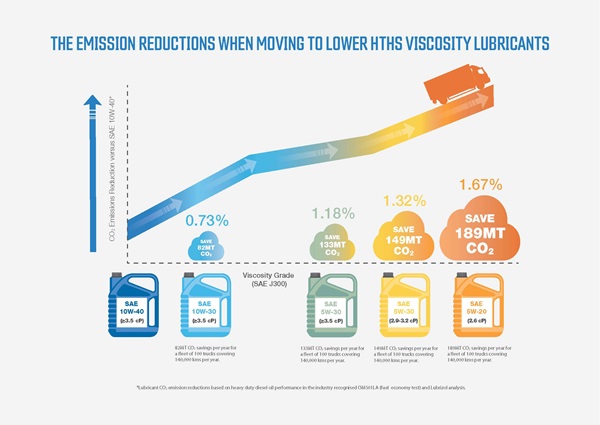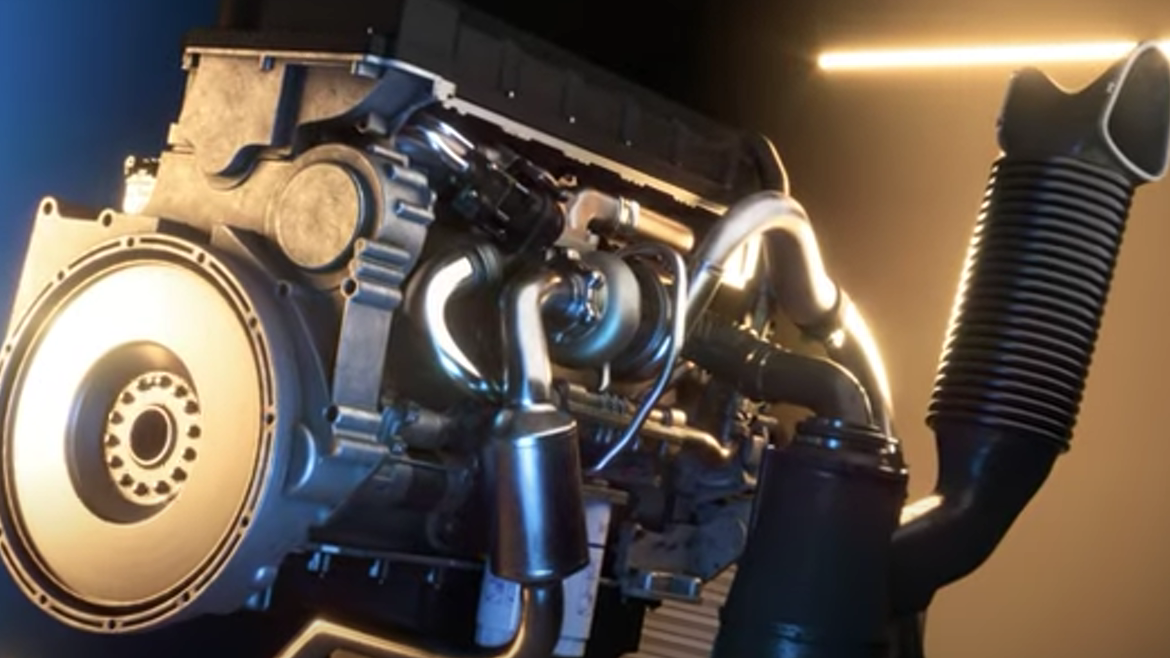Aug 12, 2021
Posted by Alex Brewster, Product Manager, Commercial Engine Lubricants
At the Paris Climate Agreement in 2019, the major economic powers agreed to limit global warming to well below 2°C and preferably below 1.5°C, compared to pre-industrial levels. Today, 194 nations have signed up to meet these goals. The target of net zero carbon dioxide (CO2) by 2050 is seen as a critical step in the journey to achieving this. Transportation is responsible for 21%1 of Europe’s total emissions of CO2. Governments and Original Equipment Manufacturers (OEMs) have responded with targets which have mainly focused on the electrification of consumer vehicles, but commitments have also been made in the commercial vehicle sector.
The movement of freight is critical for economic prosperity. All indications show that there will be continued growth in the demand for the global movement of goods. In Europe, commercial vehicles transport 14.7 billion tonnes of goods per year, transporting 77% of all goods carried over land2. As this demand for freight movement over land increases, it is imperative that we transport materials more efficiently than ever. While electrification of passenger cars has its challenges, there is relative clarity on the roadmap to zero emissions. For commercial vehicles, however, the future is less clear, and a spectrum of powertrain options are being considered. Even so, for the next two decades, the primary technology in commercial vehicles on the road in Europe will continue to be the diesel combustion engine.
Given this continued dominance of diesel engines, it is essential that emissions reduction is achieved not only from growth in the use of zero-emissions vehicles but also by continued optimization of the internal combustion engine.
Huge progress has already been made since the introduction of the Euro emission standards in 1992 to reduce the emissions output of commercial vehicles. The Euro I-VI standards for Europe lead the way, with similar standards adopted in China, India and the US which reflect regional market conditions. These standards have largely addressed emissions in the form of nitrogen oxides (NOx), particulate mass (PM) and particulate number (PN). Euro VI hardware has been in place since January 1st, 2013 and has enabled the cleanest operating diesel powertrains ever. The next iteration of the Euro VI standard (Stage E) will become mandatory in September 2021 after initial introduction in September 2020. This highlights the fact that continual improvement is being made to the diesel powertrain in commercial vehicles.
Throughout each evolution of Euro legislation, lubricants have played a vital role in enabling lower emissions in increasingly challenging hardware environments. Advances in lubricant formulations have helped to enable widespread catalyst adoption (through the use of lower phosphorous), diesel particulate filter (DPF) fitment through reduction in sulphated ash and increased oil drain intervals (through enhancements in oxidation performance).
Vehicle fuel efficiency in the form of CO2 output, not previously included in the Euro standards, has only recently been introduced. Although OEMs have increased the fuel efficiency of their vehicles during this time period, International Energy Agency (IEA) studies have shown that commercial vehicle energy consumption and tailpipe emissions have increased by 2.6% per year, with commercial vehicles responsible for more than 80% of this growth3. More commercial vehicles driving more kilometers leads to increased emissions. Rapid progress has been made in recent years, partly as a result of the Paris Agreement, to define and introduce legislation which will help to slow this rise in CO2 emissions.

In 2019, the European Commission formalized legislation which sets CO2 emission performance standards for new commercial vehicles. The headline targets that this legislation sets out are a 15% CO2 reduction by 2025 and a 30% reduction by 2030, which are accepted as extremely challenging. These reductions are based on the average CO2 emissions of those newly registered commercial vehicles in the period from 1st July 2019 to 30th June 2020 as a baseline reference. Most recently, this baseline has been defined and announced, with the average CO2 output across a range of weight classes and OEMs being 52.75g/tkm4.
The new CO2 targets laid out in Europe will begin to precipitate major changes to propulsion methods of the existing vehicle parc. A study conducted by ACEA and Potsdam Institute for Climate Impact Research (PIK) concluded that, in order to feasibly achieve these targets and carbon neutrality by 2050, all new trucks sold from 2040 would need to be fossil free. This challenging target requires a commercial vehicle parc refresh rate of 10 years versus today’s rate of close to 20 years. New powertrain technologies such as battery electric, hydrogen fuel cell and even hydrogen internal combustion engines will begin to take center stage. However, diesel powertrains will continue to play a vital role in the powertrain spectrum over the coming decades and maximizing the efficiency of these powertrains, enabling them to move cleaner.
The efficiency of the diesel powertrain can be improved in many ways and optimization of the lubricant system is an accepted approach to achieve increased efficiency. High performance lubricants at reduced viscosity grades are an important efficiency enabler which can be applied across the entire existing fleet of commercial vehicles; this is in contrast to hardware changes to the vehicle, which are generally not changeable throughout its lifetime.
Increased efficiency can be enabled through reductions in the High Temperature High Shear (HTHS) viscosity of a lubricant. When the HTHS viscosity of a lubricant is reduced, changes to the additive chemistry are necessary to ensure wear protection and durability is not compromised. The additive chemistry can also be further optimized to maximize the efficiency of the lubricant, through use of friction modifiers. Moving from an SAE 10W-40 to an SAE 5W-20 can offer fuel efficiency improvements of up to 1.7%5 while further increases are possible by friction modification. This translates to a huge contribution in vehicle parc fuel savings and CO2 reduction.

Acceptance and adoption of high efficiency, low viscosity and durable lubricants is becoming more widespread. In Europe, SAE 5W-30 lubricants at 3.5cP HTHS viscosity have displaced the commonly utilized grades of SAE 15W-40 or 10W-40 in factory fill engine lubricants for new commercial vehicles. Several OEMs are now looking to take this a step further and are utilizing SAE 5W-20 and 0W-20 lubricants at 2.6cP. Studies demonstrate that utilizing a SAE 5W-20 lubricant instead of SAE 10W-40 can save up to 1,900 MT CO2 per annum for a fleet size of 1,000 vehicles. This is the equivalent annual carbon footprint of 290 average European people. If all lubricants used for on road applications in Europe were to move to an SAE 5W-20 at 2.6cP HTHS viscosity, the total annualized saving could be 11.2 million MT CO2 in avoided emissions.
What more can be done to enable the commercial vehicles of today and tomorrow to move cleaner? New commercial vehicles are first filled in the factory with durable and efficient lubricants. However, servicing of the vehicle provides multiple choices for the quality and viscosity grade of the lubricant that can be used. Commercial vehicle operators may place greater value on convenience and lubricant cost as opposed to environmental impact and CO2 efficiency. Conventional viscosity grade lubricants can still be used rather than more efficient oils which provide tangible efficiency benefits. Ideally, the same quality and viscosity of fluids should be used for certification, initial fill, and service fill of the vehicle throughout its life. The use of lower quality fluids for ageing vehicles should be discouraged.
Now more than ever, the lubricants industry needs to demonstrate and clearly communicate how it can extract maximum efficiency from the commercial vehicle powertrain of today and tomorrow. Durable and efficient lubricants with low HTHS viscosity are readily available and effectively allow for tangible efficiency benefits and proven performance in the field for commercial vehicles.
(Originally published in LUBE Magazine.)
1 Road transport: Reducing CO2 emissions from vehicles | Climate Action (europa.eu)
2 Trucks, vans and buses | ACEA - European Automobile Manufacturers' Association
3 IEA (2020), Trucks and Buses, IEA, Paris
4 Reducing CO2 emissions from heavy-duty vehicles | Climate Action (europa.eu)
5 The emission benefits when moving to lower HTHS viscosity lubricants (infographic illustration produced by The Lubrizol Corporation)
Lubricant CO2 emission reductions based on heavy duty diesel oil performance in the industry recognised OM501LA (fuel economy test) and Lubrizol analysis.









